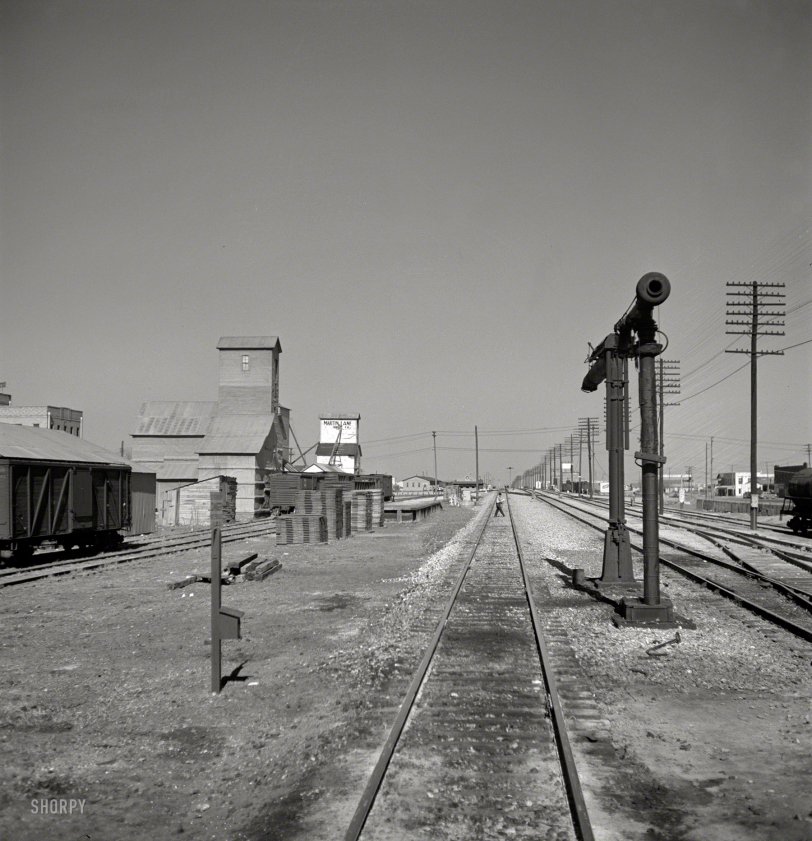


Framed or unframed, desk size to sofa size, printed by us in Arizona and Alabama since 2007. Explore now.
Shorpy is funded by you. Patreon contributors get an ad-free experience.
Learn more.

- Freeze Frame
- Texas Flyer wanted
- Just a Year Too Soon
- WWII -- Replacing men with women at the railroad crossing.
- Yes, Icing
- You kids drive me nuts!
- NOT An Easy Job
- I wonder
- Just add window boxes
- Icing Platform?
- Indiana Harbor Belt abides
- Freezing haze
- Corrections (for those who care)
- C&NW at Nelson
- Fallen Flags
- A dangerous job made worse
- Water Stop
- Passenger trains have right of way over freights?
- Coal
- Never ceases to amaze me.
- Still chuggin' (in model form)
- Great shot
- Westerly Breeze
- For the men, a trapeze
- Tickled
- Sense of loneliness ...
- 2 cents
- Charm City
- What an Outrage
- Brighton Park
Print Emporium
Pampa Depot: 1943

March 1943. "Pampa, Texas. Going through a town on the Atchison, Topeka & Santa Fe." Photo by Jack Delano, Office of War Information. View full size.
Grain Doors
The several stack of wooden panels in the middle of the picture are grain doors. before the advent of covered hopper cars to carry grain, it was typically carried in boxcars.
The regular boxcar door was opened by sliding it to the side and the grain door placed just inside the opening, nailed at each side. The grain door left a gap at the top of the door opening. The elevator worker then placed a tube through the opening to fill the car. Since grain was heavy, it would only fill the car to somewhere below the top of the grain door.
At the receiving elevator, the grain door would be breached to let the grain flow out near the bottom. Lots of shovel work getting the last of the grain out, unless the elevator had a car tipper, which would tilt the car to get most of the last of the grain out.
Sky tone
Jack Delano's work continues to amaze. In this one he probably put an orange filter over the lens to render that burning Texas sky as a middle tone of gray. Masterful control of the B&W process, indeed.
Life in a Small Town
I have never been in Pampa, TX but this picture reminds me so much of life in a small town in Kansas. The first thing you might notice is the smell of the hot creosote from the cross ties baking in the sun. Then there would be the sound of the machinery and blowers in the grain elevator. Once you get away from the sounds of the elevator there might be the sound of someone on a construction project with the sounds of hammering or sawing somewhere in the distance. Other than that, it would be mostly quiet. There might be the sound of a passing car once in a while or, maybe, the roar of a passing freight train highballing it through on the mainline. There was always the thought of having a cold one at the end of the day in the local "watering hole" and listen to the old timers telling tall tales. I would surely rather live there than in a big city.
Dropbox Dot Com
"Birdhouse? or a mailbox?"
It's probably a dropbox for waybills. They were common where cars were interchanged when / where agents weren't on duty, or when customers were switched during off-hours.
Oil column
The "stand" nearest the camera is actually an oil column. They were often co-located with watering facilities so the locomotive could take on both water and fuel in a single stop. "Stand" was a term used sometimes, but "column" was the more correct term. Water or oil "plug" was a slang term used as well.
Building on left behind box car
Looks like the same building, 5 windows, detail at top and arch above center window.
Oil and Water
The far standpipe is water, the near one is Bunker C heavy fuel oil for the oil fired steam locos.
One is oil, the other water...
Lorenzo is correct that the more distant monolith is a water crane which was found in nearly all busy steam era service facilities but I would have to say that the nearer structure is an oil column since the Santa Fe along with most other roads out west ran mostly oil fired locomotives. Oil was cheap and abundant, coal less so.
Great photo, Shorpy!
























On Shorpy:
Today’s Top 5